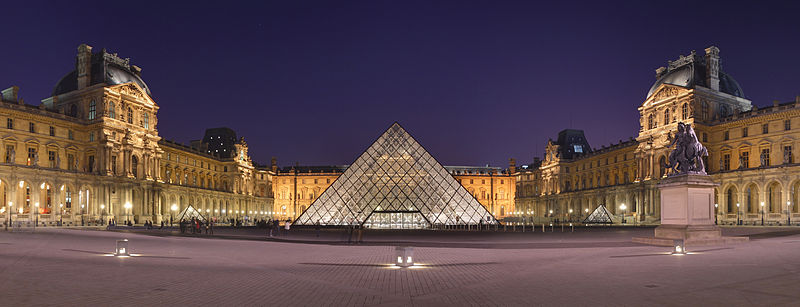The Louvre
The Louvre or the Louvre Museum is one of the world's largest museums and a historic monument in Paris, France. A central landmark of the city, it is located on the Right Bank of the Seine in the 1st arrondissement (ward). Nearly 35,000 objects from prehistory to the 21st century are exhibited over an area of 60,600 square metres (652,300 square feet). The Louvre is the world's most visited museum, receiving more than 9.26 million visitors in 2014. It is also one of the largest.

The museum is housed in the Louvre Palace, originally built as a fortress in the late 12th century under Philip II. Remnants of the fortress are visible in the basement of the museum. The building was extended many times to form the present Louvre Palace. In 1682, Louis XIV chose the Palace of Versailles for his household, leaving the Louvre primarily as a place to display the royal collection, including, from 1692, a collection of ancient Greek and Roman sculpture. In 1692, the building was occupied by the Académie des Inscriptions et Belles Lettres and the Académie Royale de Peinture et de Sculpture, which in 1699 held the first of a series of salons. The Académie remained at the Louvre for 100 years. During the French Revolution, the National Assembly decreed that the Louvre should be used as a museum to display the nation's masterpieces.
The museum opened on 10 August 1793 with an exhibition of 537 paintings, the majority of the works being royal and confiscated church property. Because of structural problems with the building, the museum was closed in 1796 until 1801. The collection was increased under Napoleon and the museum renamed the Musée Napoléon, but after Napoleon's abdication many works seized by his armies were returned to their original owners. The collection was further increased during the reigns of Louis XVIII and Charles X, and during the Second French Empire the museum gained 20,000 pieces. Holdings have grown steadily through donations and bequests since the Third Republic. The collection is divided among eight curatorial departments: Egyptian Antiquities; Near Eastern Antiquities; Greek, Etruscan and Roman Antiquities; Islamic Art; Sculpture; Decorative Arts; Paintings; Prints and Drawings.
In the World of Darkness, François Villon, Prince of Paris and France, owns the Louvre. It is, of course, an Elysium. Bunkers were built under the Louvre where Chefs d'Oeuvres can be protected, even in the case of a nuclear strike. Of course, Villon and his friends make a great use of those constructions, as the Masques have their headquarters in the Louvre. Last but not least, the Louvre seems ... alive to those with high sensibility (and/or Auspex), and some fear it is haunted... Villon seem to no give a damn (it is his palace, after all!), and indeed, when in his presence, this eerie feeling seem to disappear somewhat...
While the public parts of the Louvre is officially open to all the Kindred, the other parts are simply forbidden to anyone (unless grave exception, or for Toreador or Daughters of Cacophony!). Only on sundays can almost anyone come here to tell the Prince of her grievances. The other days, one wanting to bother the Prince must have a good reason for that. Tuesday, the Louvre is closed, and the night is for the Kindred.
Security
Shipping and Receiving (Also admission for non-Toreador) is through the sub-basement off of the Richeliu Wing. All Kindred coming in that way will be met by the Lord Chamberlian. There are scanners that can with 99% accuracy identify Kindred at all entrances, and at various points around the Louvre. Such scanners also pick up on the increased body temperature of changing breeds.
Exhibits
- -- Apollo of Piombino
